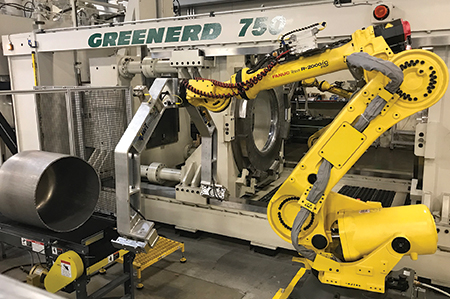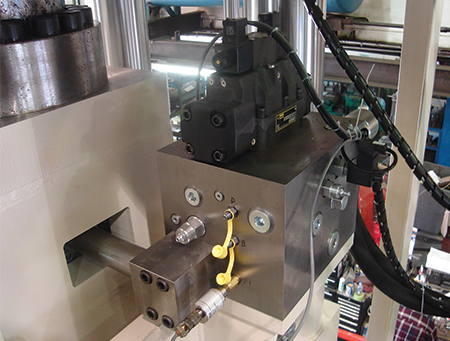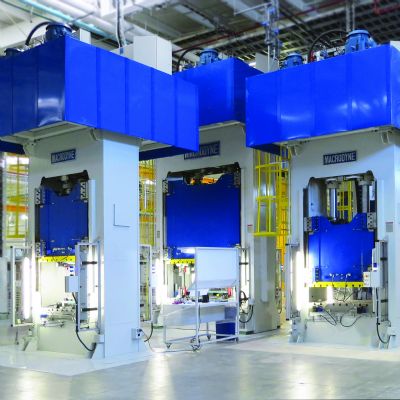MetalForming: Can ram reversal be manipulated to reduce cycle time?
Wilson: If the part does not require dwell under pressure, position reversal can be a good option, with reversal based on ram position instead of pressure. Consider a high-speed 900-ton press advancing at 1400 in./min. that must achieve a 53 in./min. pressing speed. The metalformer programs hard stops, so the ram travels downward farther than it needs to go to reach a hard-stop point, with a cushion helping to absorb force. Then the press builds tonnage to reverse back up. But once a certain downward position is attained, the extra travel to a hard stop means wasted time. And, the press builds more tonnage than is needed to form the part.
 |
| Manufacturers are recognizing the dangers surrounding equipment, and robots mitigate that, reducing cut risks due to handling sharp sheetmetal and other health risks from handling bulky, heavy and awkward parts. |
MetalForming: Can metalformers actually add speed to the press?
Wilson: We often hear from metalformers about wanting to close daylight as rapidly as possible, but they’ll hit certain limitations in this effort. The main limitation is cost. Adding pump flow, a primary method for increasing press speed, may require adding an entire circuit to the press. The key: Examine the applications—specific requirements may be more important than speed. When buying a new press, merely jumping from one frame size and motor to the next brings a significant cost jump with little corresponding increase in speed.
Know the application, and don’t specify a press to fit every possible application if all you really need is a dedicated press for one specific application. A one-size-fits-all approach can become very costly. Pre-design meetings with press manufacturers help specify your needs and fine-tune an ideal solution. Such conversations can get to the heart of what’s really important, which may not be addressed properly in a request for quote.
MetalForming: Can adding automation help reduce cycle time?
Wilson: Yes. If loading and unloading result in bottlenecks, a robot can greatly increase throughput. Hydraulic presses have become much more sophisticated in just the past 10 years, with robot integration now a simple task—and robots solve a lot of problems. Just manipulating a part to pull it out of the press may require greater press daylight for an operator than for a robot arm, maybe a few feet as compared to a few inches, and robots make the process much safer.
Manufacturers recognize the dangers surrounding equipment, and robots mitigate that, reducing cut risks due to handling sharp sheetmetal and other health risks from handling bulky, heavy and awkward parts. We recently integrated robots into one application where an operator easily loads a flat blank, but has difficulty removing the resulting awkward part. Previously, the press would open, the operator would manipulate the part out of the press and walk it over to a stack, then walk over to pick a blank, and walk it over to the press to load—so many steps here. Now, a robot pulls the part through the back of the press while the operator feeds the next blank. Robot integration brought huge cycle-time reductions.
Heavy blanks and parts also become candidates for robot integration and resulting cycle-time savings, while reducing ergonomic risks and combating operator fatigue.
MetalForming: Can hydraulic presses communicate with other line equipment and effectively mesh to help reduce cycle time?
Wilson: Handshaking with auxiliary equipment—optimizing initiation of a feeder, robot or other equipment for press entry and exit—offers plenty of opportunity to cut cycle time. Especially with older equipment and retrofits, we see exaggerated motion. A press ram may travel all the way up and stop, and then trigger a robot or some other equipment to feed—a lot of wasted motion. A mid-stroke setpoint versus waiting until a press top-stop provides a simple fix here.
With modern equipment, we know exactly where the platen locates at all times. We know when space is free to feed while the platen is still moving, and don’t have to wait for a relay. Programming and controls will start the robot moving toward a part grab, which saves time. Or, during a blank feed, the line knows when the operator has cleared the work area, enabling safe equipment movement. Light-curtain technology senses the number of breaks and the press and auxiliary equipment can act accordingly to quicken the cycle.
With hydraulic presses, taking advantage of all of these things add up to significant cycle-time savings. MF
View Glossary of Metalforming Terms
See also: Greenerd Press & Machine Co.
Technologies: Pressroom Automation, Stamping Presses










